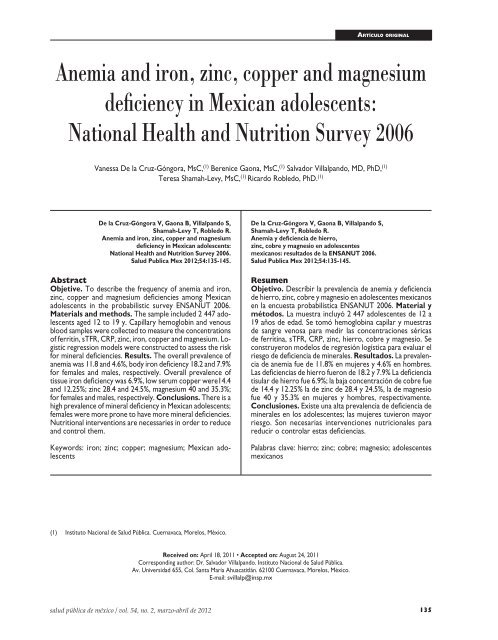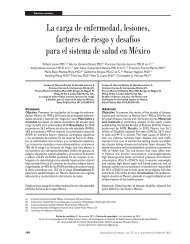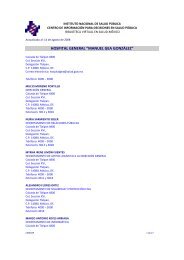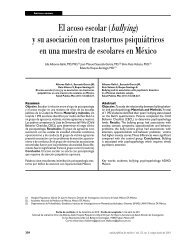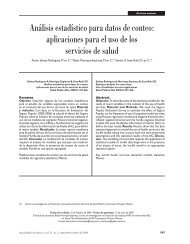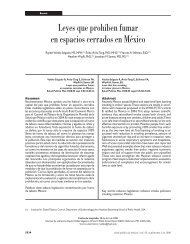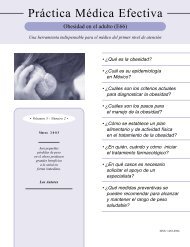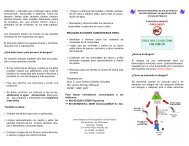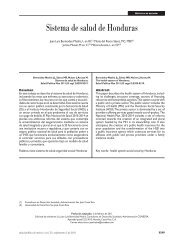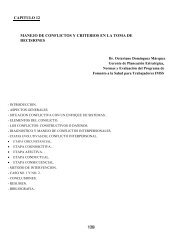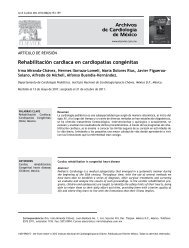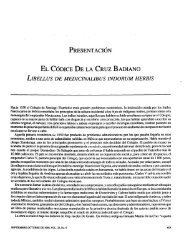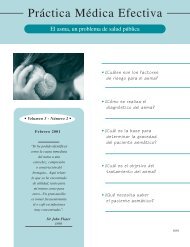Anemia and iron, zinc, copper and magnesium deficiency in ...
Anemia and iron, zinc, copper and magnesium deficiency in ...
Anemia and iron, zinc, copper and magnesium deficiency in ...
Create successful ePaper yourself
Turn your PDF publications into a flip-book with our unique Google optimized e-Paper software.
M<strong>in</strong>eral <strong>deficiency</strong> <strong>in</strong> Mexican adolescents Ar t í c u l o orig<strong>in</strong>Al<br />
<strong>Anemia</strong> <strong>and</strong> <strong>iron</strong>, <strong>z<strong>in</strong>c</strong>, <strong>copper</strong> <strong>and</strong> <strong>magnesium</strong><br />
<strong>deficiency</strong> <strong>in</strong> Mexican adolescents:<br />
National Health <strong>and</strong> Nutrition Survey 2006<br />
Vanessa De la Cruz-Góngora, MsC, (1) Berenice Gaona, MsC, (1) Salvador Villalp<strong>and</strong>o, MD, PhD, (1)<br />
Teresa Shamah-Levy, MsC, (1) Ricardo Robledo, PhD. (1)<br />
De la Cruz-Góngora V, Gaona B, Villalp<strong>and</strong>o S,<br />
Shamah-Levy T, Robledo R.<br />
<strong>Anemia</strong> <strong>and</strong> <strong>iron</strong>, <strong>z<strong>in</strong>c</strong>, <strong>copper</strong> <strong>and</strong> <strong>magnesium</strong><br />
<strong>deficiency</strong> <strong>in</strong> Mexican adolescents:<br />
National Health <strong>and</strong> Nutrition Survey 2006.<br />
Salud Publica Mex 2012;54:135-145.<br />
Abstract<br />
Objetive. To describe the frequency of anemia <strong>and</strong> <strong>iron</strong>,<br />
<strong>z<strong>in</strong>c</strong>, <strong>copper</strong> <strong>and</strong> <strong>magnesium</strong> deficiencies among Mexican<br />
adolescents <strong>in</strong> the probabilistic survey ENSANUT 2006.<br />
Materials <strong>and</strong> methods. The sample <strong>in</strong>cluded 2 447 adolescents<br />
aged 12 to 19 y. Capillary hemoglob<strong>in</strong> <strong>and</strong> venous<br />
blood samples were collected to measure the concentrations<br />
of ferrit<strong>in</strong>, sTFR, CRP, <strong>z<strong>in</strong>c</strong>, <strong>iron</strong>, <strong>copper</strong> <strong>and</strong> <strong>magnesium</strong>. Logistic<br />
regression models were constructed to assess the risk<br />
for m<strong>in</strong>eral deficiencies. Results. The overall prevalence of<br />
anemia was 11.8 <strong>and</strong> 4.6%, body <strong>iron</strong> <strong>deficiency</strong> 18.2 <strong>and</strong> 7.9%<br />
for females <strong>and</strong> males, respectively. Overall prevalence of<br />
tissue <strong>iron</strong> <strong>deficiency</strong> was 6.9%, low serum <strong>copper</strong> were14.4<br />
<strong>and</strong> 12.25%; <strong>z<strong>in</strong>c</strong> 28.4 <strong>and</strong> 24.5%, <strong>magnesium</strong> 40 <strong>and</strong> 35.3%;<br />
for females <strong>and</strong> males, respectively. Conclusions. There is a<br />
high prevalence of m<strong>in</strong>eral <strong>deficiency</strong> <strong>in</strong> Mexican adolescents;<br />
females were more prone to have more m<strong>in</strong>eral deficiencies.<br />
Nutritional <strong>in</strong>terventions are necessaries <strong>in</strong> order to reduce<br />
<strong>and</strong> control them.<br />
Keywords: <strong>iron</strong>; <strong>z<strong>in</strong>c</strong>; <strong>copper</strong>; <strong>magnesium</strong>; Mexican adolescents<br />
(1) Instituto Nacional de Salud Pública. Cuernavaca, Morelos, México.<br />
Received on: April 18, 2011 • Accepted on: August 24, 2011<br />
Correspond<strong>in</strong>g author: Dr. Salvador Villalp<strong>and</strong>o. Instituto Nacional de Salud Pública.<br />
Av. Universidad 655, Col. Santa María Ahuacatitlán. 62100 Cuernavaca, Morelos, México.<br />
E-mail: svillalp@<strong>in</strong>sp.mx<br />
salud pública de méxico / vol. 54, no. 2, marzo-abril de 2012<br />
De la Cruz-Góngora V, Gaona B, Villalp<strong>and</strong>o S,<br />
Shamah-Levy T, Robledo R.<br />
<strong>Anemia</strong> y deficiencia de hierro,<br />
<strong>z<strong>in</strong>c</strong>, cobre y magnesio en adolescentes<br />
mexicanos: resultados de la ENSANUT 2006.<br />
Salud Publica Mex 2012;54:135-145.<br />
Resumen<br />
Objetivo. Describir la prevalencia de anemia y deficiencia<br />
de hierro, <strong>z<strong>in</strong>c</strong>, cobre y magnesio en adolescentes mexicanos<br />
en la encuesta probabilística ENSANUT 2006. Material y<br />
métodos. La muestra <strong>in</strong>cluyó 2 447 adolescentes de 12 a<br />
19 años de edad. Se tomó hemoglob<strong>in</strong>a capilar y muestras<br />
de sangre venosa para medir las concentraciones séricas<br />
de ferrit<strong>in</strong>a, sTFR, CRP, <strong>z<strong>in</strong>c</strong>, hierro, cobre y magnesio. Se<br />
construyeron modelos de regresión logística para evaluar el<br />
riesgo de deficiencia de m<strong>in</strong>erales. Resultados. La prevalencia<br />
de anemia fue de 11.8% en mujeres y 4.6% en hombres.<br />
Las deficiencias de hierro fueron de 18.2 y 7.9% La deficiencia<br />
tisular de hierro fue 6.9%; la baja concentración de cobre fue<br />
de 14.4 y 12.25% la de <strong>z<strong>in</strong>c</strong> de 28.4 y 24.5%, la de magnesio<br />
fue 40 y 35.3% en mujeres y hombres, respectivamente.<br />
Conclusiones. Existe una alta prevalencia de deficiencia de<br />
m<strong>in</strong>erales en los adolescentes; las mujeres tuvieron mayor<br />
riesgo. Son necesarias <strong>in</strong>tervenciones nutricionales para<br />
reducir o controlar estas deficiencias.<br />
Palabras clave: hierro; <strong>z<strong>in</strong>c</strong>; cobre; magnesio; adolescentes<br />
mexicanos<br />
135
Ar t í c u l o orig<strong>in</strong>Al<br />
The <strong>deficiency</strong> of micronutrients is a health issue<br />
far from be<strong>in</strong>g resolved globally. 1 Some m<strong>in</strong>eral<br />
deficiencies as such <strong>iron</strong> <strong>and</strong> <strong>z<strong>in</strong>c</strong> impact negatively<br />
on physical growth, immune response, cognitive <strong>and</strong><br />
emotional development, among others. 2<br />
There is limited <strong>in</strong>formation on the m<strong>in</strong>eral status of<br />
<strong>copper</strong> <strong>and</strong> <strong>magnesium</strong> <strong>in</strong> adolescents. In adult German<br />
population, prevalence of <strong>magnesium</strong> <strong>deficiency</strong> reached<br />
14.5%. 3 Knovich et al reported an association between serum<br />
<strong>copper</strong> levels <strong>and</strong> anaemia <strong>in</strong> American population<br />
(NHANES II). 4 Reports on the prevalence of anemia, <strong>iron</strong><br />
<strong>and</strong> <strong>z<strong>in</strong>c</strong> <strong>deficiency</strong> are available for several groups of<br />
adolescents; 5-7 vary<strong>in</strong>g from 2% to 5% for <strong>z<strong>in</strong>c</strong> <strong>deficiency</strong><br />
<strong>in</strong> British, 43% <strong>in</strong> Ethiopia <strong>and</strong> over 50% <strong>in</strong> Sri Lanka<br />
population. Also were found 24% of <strong>iron</strong> <strong>deficiency</strong> <strong>in</strong><br />
Sri Lanka. The Mexican National Nutrition Survey -1999<br />
(NNS-99), described the prevalences of anemia, <strong>iron</strong>, <strong>z<strong>in</strong>c</strong><br />
<strong>and</strong> iod<strong>in</strong>e status <strong>in</strong> women between 12 <strong>and</strong> 49 years of<br />
age. The overall prevalence of anemia was 20.8%, 8 <strong>iron</strong><br />
<strong>deficiency</strong> was 40% <strong>and</strong> <strong>z<strong>in</strong>c</strong> <strong>deficiency</strong> 30%. 9 However<br />
no dist<strong>in</strong>ctions were made for adolescents. No <strong>in</strong>formation<br />
is available for cooper <strong>and</strong> <strong>magnesium</strong> deficiencies<br />
<strong>in</strong> population-based surveys <strong>in</strong> Mexico. The objective<br />
of the present analysis is to describe the frequency <strong>and</strong><br />
distribution of anemia <strong>and</strong> <strong>iron</strong>, <strong>z<strong>in</strong>c</strong>, <strong>copper</strong> <strong>and</strong> <strong>magnesium</strong><br />
deficiencies among Mexican adolescents, aim<strong>in</strong>g<br />
to identify opportunities for <strong>in</strong>tervention.<br />
Population <strong>and</strong> methods<br />
Study population. Information for the present analysis<br />
was extracted from the dataset of the Mexican National<br />
Health <strong>and</strong> Nutrition Survey of 2006 (ENSANUT 2006).<br />
This is a probabilistic survey, representative at the national,<br />
regional, urban <strong>and</strong> rural levels.<br />
A detailed description of the design <strong>and</strong> sampl<strong>in</strong>g<br />
procedures was published elsewhere. 10 Demographic<br />
<strong>and</strong> socioeconomic <strong>in</strong>formation was collected us<strong>in</strong>g<br />
ad hoc questionnaires. Ethnicity was classified if an<br />
<strong>in</strong>digenous language was spoken. Localities with less<br />
than 2 500 <strong>in</strong>habitants were considered as rurals. A<br />
socioeconomic <strong>in</strong>dex was constructed based on the<br />
household characteristics <strong>and</strong> family assets by a pr<strong>in</strong>cipal<br />
component analysis, the <strong>in</strong>dex was divided <strong>in</strong>to<br />
tertiles be<strong>in</strong>g 1 the lowest. The country was divided <strong>in</strong><br />
four geographic regions: Northern, Center, Mexico City<br />
<strong>and</strong> Southern. Anthropometric <strong>in</strong>formation (weight <strong>and</strong><br />
height) was collected us<strong>in</strong>g validated <strong>and</strong> st<strong>and</strong>ardized<br />
methods. 11,12 Body Mass Index (BMI) was computed<br />
based on height <strong>and</strong> weight. 13<br />
This sample (n= 2 447), was extracted from the<br />
general dataset of the ENSANUT 2006 <strong>in</strong>clud<strong>in</strong>g 12-19<br />
yrs of age with a blood sample available.<br />
De la Cruz-Góngora V y col.<br />
Methods for serum m<strong>in</strong>eral<br />
concentrations <strong>and</strong> C reactive prote<strong>in</strong><br />
Venous blood samples were drawn <strong>and</strong> centrifuged at<br />
268 g, <strong>in</strong> situ. Serum was separated <strong>and</strong> stored <strong>in</strong> coded<br />
cryovials, preserved <strong>in</strong> liquid nitrogen until delivery to<br />
a central laboratory <strong>in</strong> Cuernavaca, Mexico.<br />
The serum concentrations of ferrit<strong>in</strong>, soluble transferr<strong>in</strong><br />
receptors (sTfR) were measured by immunoassay<br />
method us<strong>in</strong>g commercial kits (Dade Behr<strong>in</strong>g Inc). C<br />
reactive prote<strong>in</strong> (CRP) was measured by nephelometry,<br />
us<strong>in</strong>g ultra sensitive monoclonal antibodies (Behr<strong>in</strong>g<br />
Nephelometer 100 Analyzer).<br />
Low <strong>iron</strong> stores (LIS) was def<strong>in</strong>ed if serum concentrations<br />
of ferrit<strong>in</strong> 6 mg/L.<br />
The total body <strong>iron</strong> (TBI) (mg/kg) was calculated<br />
based on the concentrations of sTfR <strong>and</strong> s-ferrit<strong>in</strong> us<strong>in</strong>g<br />
the Cook’s equation. 14<br />
The serum concentrations of <strong>iron</strong>, <strong>z<strong>in</strong>c</strong>, <strong>copper</strong> <strong>and</strong><br />
<strong>magnesium</strong> were measured by <strong>in</strong>ductively coupled<br />
plasma atomic emission spectroscopy us<strong>in</strong>g a Varian<br />
Vista Pro CCD spectrometer.<br />
Z<strong>in</strong>c <strong>deficiency</strong> was def<strong>in</strong>ed if
M<strong>in</strong>eral <strong>deficiency</strong> <strong>in</strong> Mexican adolescents Ar t í c u l o orig<strong>in</strong>Al<br />
to the Dietary Reference Intakes (DRI) of the Institute<br />
of Medic<strong>in</strong>e of USA. 19<br />
Statistical analysis<br />
The characteristics of the sample are described as frequencies<br />
<strong>and</strong> 95% confidence <strong>in</strong>tervals, stratified by sex.<br />
The distribution of TBI, age <strong>and</strong> sex <strong>in</strong>teractions were<br />
evaluated through multiple l<strong>in</strong>ear regression models.<br />
Logistic regression models were constructed to test the<br />
risks for low tissue <strong>iron</strong>, low serum <strong>z<strong>in</strong>c</strong>, <strong>copper</strong> <strong>and</strong><br />
<strong>magnesium</strong>. Heterogeneity of effects by sex <strong>and</strong> age<br />
were tested adjusted by Socioeconomic Status (SES),<br />
BMI, CRP, dwell<strong>in</strong>g, geographical regions, ethnicity <strong>and</strong><br />
be<strong>in</strong>g beneficiary of Oportunidades.<br />
Statistical significance was set at α=0.05 <strong>and</strong> α=0.1<br />
for <strong>in</strong>teractions. All analyses were adjusted for the<br />
sampl<strong>in</strong>g design of the survey, us<strong>in</strong>g STATA SE v11.<br />
The protocol was approved by the Research, Ethics,<br />
<strong>and</strong> Biosecurity Comitee of Instituto Nacional de<br />
Salud Pública, Mexico. Individual assents <strong>and</strong> <strong>in</strong>formed<br />
consent letters were obta<strong>in</strong>ed from the parents of all<br />
participants.<br />
Results<br />
This analysis <strong>in</strong>cludes 2 447 adolescents. The characteristics<br />
of the sample are presented <strong>in</strong> Table I. Briefly, the<br />
mean age was 15.1 y, with a proportion male/female<br />
45.9/54.1; 34.1% lived <strong>in</strong> rural areas, 7.1% were of Indian<br />
ethnicity <strong>and</strong> 35.4% were overweight/obese (Table I).<br />
Prevalence of anemia<br />
The overall prevalence of anemia was 8.5%, greater <strong>in</strong><br />
females (11.8%), than <strong>in</strong> males (4.6%).<br />
The geometric mean of s-ferrit<strong>in</strong> was lower <strong>in</strong> the<br />
anemic than <strong>in</strong> the non anemic subjects (18.32 µg/L<br />
vs 32.14 µg/L, respectively, p
Ar t í c u l o orig<strong>in</strong>Al<br />
Table I<br />
Description o f t h e s a m p l e o f a D o l e s c e n t s. ensanUt 2006*<br />
De la Cruz-Góngora V y col.<br />
n=2447<br />
Females Males Overall<br />
Expansion ‡ Expansion ‡<br />
n n % (95% CI) n n % (95% CI) % (95% CI)<br />
Sample (thous<strong>and</strong>s) Sample (thous<strong>and</strong>s)<br />
Age (years) § 1356 10 069.60 15.18 (14.98, 15.37) 1045 8 658.20 15.06 (14.88, 15.25) 15.12 (14.98, 15.27)<br />
Dwell<strong>in</strong>g<br />
Urban 867 6 788.60 67.5 (63.27, 71.5) 718 6 241.00 72.3 (67.58, 76.52) 69.54 (65.92, 72.94)<br />
Rural 486 3 266.00 32.5 (28.5, 36.73) 326 2 394.50 27.7 (23.48, 32.42) 30.46 (27.06, 34.08)<br />
Region<br />
Northern 202 1 428.70 14.2 (11.28, 17.75) 176 1 298.80 15.0 (11.84, 18.93) 14.59 (11.86, 17.83)<br />
Center 632 3 481.30 34.6 (29.44, 40.2) 390 2 426.40 28.1 (23.21, 33.57) 31.61 (27.09, 36.51)<br />
Mexico City 45 1 449.10 14.4 (10.22, 19.94) 37 1 123.00 13.0 (8.96, 18.5) 13.76 (10.24, 18.24)<br />
Southern 474 3 695.60 36.8 (31.42, 42.43) 441 3 787.30 43.9 (37.9, 49.99) 40.04 (35.02, 45.28)<br />
Socioeconomic status (tertile)<br />
1 (Low) 595 4 364.80 43.6 (39.36, 47.85) 411 3 319.60 38.5 (33.81, 43.36) 41.21 (37.83, 44.67)<br />
2 (Medium) 471 3 356.60 33.5 (29.66, 37.57) 370 2 895.10 33.6 (29.54, 37.83) 33.53 (30.65, 36.53)<br />
3 (High) 284 2 298.80 22.9 (19.64, 26.62) 261 2 412.50 28.0 (24.12, 32.16) 25.27 (22.56, 28.17)<br />
Oportunidades affiliation<br />
Yes 495 3 042.50 30.3 (26.78, 34.04) 316 2 362.80 27.4 (23.74, 31.49) 28.98 (26.09, 32.04)<br />
No 855 7 002.30 69.7 (65.96, 73.22) 725 6 246.50 72.6 (68.51, 76.26) 71.02 (67.96, 73.91)<br />
Ethnicity<br />
Non <strong>in</strong>digenous 1274 9 598.00 95.3 (92.92, 96.93) 988 8 178.50 94.5 (91.78, 96.3) 94.92 (92.82, 96.43)<br />
Indigenous 82 471.6 4.7 (3.07, 7.08) 57 479.6 5.5 (3.7, 8.22) 5.08 (3.57, 7.18)<br />
BMI (kg/m2) § 1307 9 746.30 22.74 (22.38, 23.11) 1001 8 279.60 22.16 (21.75, 22.56) 22.47 (22.21, 22.74)<br />
Nutritional status<br />
Normal 863 6 294.20 65.1 (61.1, 68.8) 674 5 770.60 70.1 (65.9, 74.05) 67.39 (64.54, 70.11)<br />
Overweight/obesity 431 3 381.90 35.0 (31.2, 38.9) 316 2 457.20 29.9 (25.95, 34.1) 32.61 (29.89, 35.46)<br />
C-Reactive prote<strong>in</strong> (mg/dL)<br />
(geometric mean) § 1343 9 930.20 0.73 (0.67, 0.81) 1034 8 533.40 0.59 (0.53, 0.66) 0.67 (0.62, 0.72)<br />
Inflammation<br />
C-reactive prote<strong>in</strong><br />
6 mg/dL<br />
Age at menarche<br />
113 767.3 7.7 (5.98, 9.93) 78 579 6.8 (5.14, 8.91) 7.29 (6.03, 8.79)<br />
(years) § 1168 8 568.10 12.07 (11.97, 12.17) 12.07 (11.97, 12.17)<br />
* Values are frequencies (95% C.I.) unless otherwise <strong>in</strong>dicated<br />
‡ N (thous<strong>and</strong>s) is the expansion for overall population expressed <strong>in</strong> thous<strong>and</strong>s<br />
§ Values are means (95% C.I.)<br />
138 salud pública de méxico / vol. 54, no. 2, marzo-abril de 2012
M<strong>in</strong>eral <strong>deficiency</strong> <strong>in</strong> Mexican adolescents Ar t í c u l o orig<strong>in</strong>Al<br />
salud pública de méxico / vol. 54, no. 2, marzo-abril de 2012<br />
Table II<br />
pr e v a l e n c e o f i r o n D e f i c i e n c y m e a s U r e D t h r o U g h f e r r i t i n s e r U m a n D s o l U b l e t r a n s f e r r i n r e c e p t o r s<br />
c o n c e n t r a t i o n s. ensanUt 2006<br />
Females Males n= 2 398<br />
Expansion* Expansion*<br />
n n Prevalence (95% CI) n n Prevalence (95% CI) Overall (95% CI)<br />
Sample (Thous<strong>and</strong>s) Sample (Thous<strong>and</strong>s)<br />
Iron <strong>deficiency</strong> measured as serum ferrit<strong>in</strong> < 12 ug/L<br />
Overall national 1 353 9 903.8 18.24 (15.16, 21.33) 1 045 8 538.8 7.9 (5.70, 10.07) 13.45 (11.52, 15.65)<br />
Age group<br />
12-14 619 4 254.1 14.48 (10.95, 18.01) 503 4 067.2 11 (7.45, 14.53) 12.77 (10.11, 15.43)<br />
15-19 734 5 649.7 21.07 (16.34, 25.81) 542 4 471.6 5.07 (2.56, 7.57) 14.01 (10.88, 17.12)<br />
Dwell<strong>in</strong>g<br />
Rural 479 3 200.3 15.51 (11.18, 19.8) 324 2 359.0 9.31 (5.4, 13.22) 12.88 (9.84, 15.91)<br />
Urban 856 6 688.6 19.43 (15.37, 23.48) 708 6 157.1 7.37 (4.73, 10.02) 13.65 (11.01, 16.3)<br />
Region<br />
Northern 200 1 412.9 18.67 (11.62, 25.73) 172 1 265.8 7.8 (3.41, 12.19) 13.54 (9.45, 17.62)<br />
Center 628 3 462.7 15.95 (11.78, 20.11) 387 2 402.8 9.86 (5.48, 14.23) 13.45 (10.7, 16.21)<br />
Mexico City 44 1 419.3 13.5 (3.3, 23.70) 37 1 123.0 no obs - 7.53 (1.47, 13.6)<br />
Southern 463 3 594.1 21.93 (16.5, 27.37) 436 3 724.5 9.07 (5.32, 12.82) 15.39 (11.57, 19.2)<br />
Socioeconomic status (tertile)<br />
1 (Low) 585 4 270.1 19.43 (14.84, 24.03) 408 3 278.9 9.6 (5.76, 13.4) 15.15 (12.09, 18.21)<br />
2 (Medium) 464 3 296.3 16.3 (11.22, 21.37) 366 2 843.5 7.81 (4.24, 11.4) 12.37 (9.03, 15.70)<br />
3 (High) 283 2 288.2 18.14 (11.81, 24.46) 256 2 385.4 5.4 (2.30, 8.51) 11.64 (8.14, 15.14)<br />
Ethnicity<br />
Indigenous 97 471.6 20.61 (09.34, 31.88) 68 460.4 6.2 (-1.32, 13.71) 13.5 (6.82, 20.16)<br />
Non <strong>in</strong>digenous 1256 9 432.2 18.12 (14.93, 21.32) 977 8 078.4 8 (5.70, 10.27) 13.44 (11.29, 15.6)<br />
Oportunidades affiliation<br />
Yes 488 2 969.7 13.5 (9.46, 17.5) 312 2 308.0 12.04 (7.18, 16.90) 12.85 (9.75, 15.94)<br />
No 845 6 912.2 20.12 (16.03, 24.21) 717 6 181.9 6.1 (3.76, 8.44) 13.5 (10.92, 16.08)<br />
Tissue <strong>iron</strong> <strong>deficiency</strong> as by the concentration of soluble transferr<strong>in</strong> receptors >6 mg/L n = 2 398<br />
Overall national 1 354 9 894.1 7.42 (5.37, 9.48) 1 044 8 533.8 6.42 (4.11, 8.72) 6.96 (5.61, 8.61)<br />
Group age<br />
12-14 618 4 235.2 3.43 (1.80, 5.06) 501 4 057.6 12.46 (7.89, 17.03) 7.85 (5.40, 10.30)<br />
15-19 736 5 659.0 10.41 (7.04, 13.78) 543 4 476.2 0.93 (0.26, 1.61) 6.23 (4.30, 8.15)<br />
Dwell<strong>in</strong>g<br />
Rural 477 3 169.0 6.47 (3.47, 9.47) 323 2 347.4 5.6 (1.79, 9.42) 6.1 (3.80, 8.40)<br />
Urban 859 6 710.1 7.86 (5.19, 10.53) 708 6 163.8 6.7 (3.92, 9.58) 7.33 (5.43, 9.22)<br />
Region<br />
Northern 199 1 411.6 7.77 (3.59, 11.95) 173 1 275.1 4.67 (1.23, 8.11) 6.3 (3.52, 9.07)<br />
Center 628 3 462.7 7.98 (4.30, 11.67) 387 2 402.8 7.77 (3.59, 11.95) 6.68 (4.26, 9.09)<br />
Mexico City 44 1 419.3 7.55 (0.2, 14.9) 37 1 123.0 14 (2.92, 25.01) 10.4 (4.05, 16.72)<br />
Southern 465 3 585.6 6.66 (3.78, 9.55) 434 3 710.2 5.82 (2.82, 8.82) 6.24 (4.15, 8.32)<br />
Socioeconomic status (tertile)<br />
1 (Low) 584 4 242.7 9.74 (6.08, 13.4) 405 3 260.0 5.54 (2.17, 8.91) 7.92 (5.39, 10.44)<br />
2 (Medium) 465 3 303.3 5.2 (2.15, 8.25) 367 2 852.8 8.3 (3.84, 12.73) 6.63 (4.03, 9.22)<br />
3 (High) 284 2 298.8 6.41 (2.55, 10.27) 257 2 390.0 5.45 (0.80, 10.11) 5.92 (2.82, 9.02)<br />
Ethnicity<br />
Indigenous 94 436.7 6.86 (1.57, 12.15) 67 448.8 4.58 (-1.57, 10.73) 5.7 (1.69, 9.71)<br />
Non <strong>in</strong>digenous 1260 9 457.4 7.45 (5.32, 9.58) 977 8 085.0 6.52 (4.11, 8.92) 7.02 (5.46, 8.58)<br />
Oportunidades affiliation<br />
Yes 487 2 949.4 4 (2.08, 5.92) 311 2 296.4 7.81 (3.19, 12.43) 5.66 (3.33, 8.01)<br />
No 847 6 922.9 8.88 (6.07, 11.68) 717 6 188.5 6 (3.26, 8.63) 7.5 (5.6, 9.4)<br />
* N (thous<strong>and</strong>s) is the expansion for overall population expressed <strong>in</strong> thous<strong>and</strong>s<br />
139
Ar t í c u l o orig<strong>in</strong>Al<br />
Table III<br />
pr e v a l e n c e o f l o w s e r U m c o p p e r, m a g n e s iU m a n D z i n c <strong>in</strong> a D o l e s c e n t s.<br />
ensanUt 2006<br />
De la Cruz-Góngora V y col.<br />
Females Males<br />
Expansion* Expansion*<br />
n n Prevalence (95% CI) n n Prevalence (95% CI) Overall (95% CI)<br />
Sample (Thous<strong>and</strong>s) Sample (Thous<strong>and</strong>s)<br />
Low serum <strong>copper</strong>
M<strong>in</strong>eral <strong>deficiency</strong> <strong>in</strong> Mexican adolescents Ar t í c u l o orig<strong>in</strong>Al<br />
(Cont<strong>in</strong>ued)<br />
Ethnicity<br />
Indigenous 29 2,273.4 18.39 (7.01 , 40.23) 44 169.5 28.23 (10.43 , 57.08) 22.59 (10.72 , 41.5)<br />
Non <strong>in</strong>digenous 705 62,543.3 24.73 (19.95 , 30.21) 975 7,501.3 28.08 (23.65 , 32.98) 26.56 (22.85 , 30.63)<br />
Oportunidades affiliation<br />
Yes 192 14,536.4 25.43 (16.49 , 37.06) 355 2,184.9 27.26 (19.74 , 36.35) 26.53 (19.67 , 34.75)<br />
No 539 49,870.2 24.10 (18.99 , 30.08) 660 5,473.6 28.44 (23.39 , 34.09) 26.37 (22.49 , 30.66)<br />
Low serum <strong>magnesium</strong>
Ar t í c u l o orig<strong>in</strong>Al<br />
De la Cruz-Góngora V y col.<br />
Table IV<br />
logistic r e g r e s s i o n m o D e l s f o r p r e D i c t e D v a r i a b l e s o f m i c r o nU t r i e n t s D e f i c i e n c y. ensanUt 2006<br />
Model 1 Model 2 Model 3 Model 4 Model 5<br />
Depent variable Low <strong>iron</strong> stores Tissue <strong>iron</strong> <strong>deficiency</strong> Low serum <strong>copper</strong> Z<strong>in</strong>c <strong>deficiency</strong> Low serum <strong>magnesium</strong><br />
(Ferrit<strong>in</strong> < 12 μg/L) (TfR >6 mg/L) (
M<strong>in</strong>eral <strong>deficiency</strong> <strong>in</strong> Mexican adolescents Ar t í c u l o orig<strong>in</strong>Al<br />
Body <strong>iron</strong> (mg/kg)<br />
12<br />
10<br />
8<br />
6<br />
4<br />
12 14 16 18 20<br />
Age (years)<br />
95% CI Female Male<br />
fi g U r e 1. ef f e c t o f a g e o n t o t a l b o D y i r o n b y s e x <strong>in</strong><br />
me x i c a n a D o l e s c e n t s. ensanUt 2006<br />
Discussion<br />
We present evidence here<strong>in</strong> for a high prevalence of <strong>iron</strong>,<br />
<strong>z<strong>in</strong>c</strong>, <strong>copper</strong> <strong>and</strong> <strong>magnesium</strong> deficiencies <strong>in</strong> Mexican<br />
male <strong>and</strong> female adolescents. Females were more prone<br />
to suffer most of m<strong>in</strong>eral deficiencies. When compar<strong>in</strong>g<br />
the prevalence of LIS <strong>in</strong> female adolescents <strong>in</strong> the<br />
NNS-99 with those here<strong>in</strong> reported, there is a decrement<br />
<strong>in</strong> the prevalence (40.5% vs 18.4%). 9,20 However,<br />
methodological differences may confound such a big<br />
decrease; <strong>in</strong> 1999 LIS was assessed by percent saturation<br />
of transferr<strong>in</strong>, while <strong>in</strong> 2006 a direct measurement<br />
of s-ferrit<strong>in</strong> was used.<br />
The puberty onset is probably critical to enhance<br />
the sexual differences <strong>in</strong> TBI <strong>in</strong> this study, i.e. a larger<br />
growth of muscle mass <strong>in</strong> males 21 <strong>and</strong> losses of <strong>iron</strong><br />
throughout menstruation results <strong>in</strong> larger TBI <strong>in</strong> males<br />
relative to females. Information on population based<br />
estimates of TBI are scanty; data from NHANES III<br />
reported <strong>in</strong> adults older than 20 years mean TBI values<br />
of 9.89 ± 2.82 mg/kg for males <strong>and</strong> 4.87 ±4.14 mg/kg for<br />
females, 14 similar to those reported here<strong>in</strong>. We are aware<br />
that Cook’s equation is not validated for adolescents,<br />
however, even if the external validity may be questionable,<br />
the <strong>in</strong>ternal validity allows for valid comparisons<br />
between both genders. We made efforts to homologate<br />
our TfR results to Cook’s laboratory, correct<strong>in</strong>g as by<br />
Ramco’s kit.<br />
In the present study, the majority of cases of anemia<br />
were not expla<strong>in</strong>ed by ID; other nutritional causes of<br />
anemia as such folate <strong>and</strong> vitam<strong>in</strong> B12 deficiencies were<br />
not evaluated. 22 However, the adequacy of the dietary<br />
<strong>in</strong>take of vitam<strong>in</strong> B12 was 110%, while the adequacy<br />
for folate was 70%. This may expla<strong>in</strong>, <strong>in</strong> part, the high<br />
salud pública de méxico / vol. 54, no. 2, marzo-abril de 2012<br />
proportion of non IDA. Both, low <strong>and</strong> excessive <strong>copper</strong><br />
serum concentrations are associated with IDA. 4,23 In our<br />
study, adolescents with anemia had significantly higher<br />
serum concentrations of <strong>copper</strong> than their non anemia<br />
counterparts, <strong>in</strong> l<strong>in</strong>e with the reported by NHANES-II. 4<br />
The association between <strong>iron</strong> <strong>and</strong> <strong>copper</strong> deficiencies<br />
is most probably due to the role of <strong>copper</strong> as a cofactor<br />
of <strong>iron</strong> oxidiz<strong>in</strong>g prote<strong>in</strong>s as such hefast<strong>in</strong> <strong>and</strong> ceruloplasm<strong>in</strong>e.<br />
24<br />
The possibility of subestimat<strong>in</strong>g ID as a cause of<br />
anemia could be <strong>in</strong>fluenced by acute <strong>in</strong>fections <strong>and</strong><br />
<strong>in</strong>flammation. However, the rate of acute <strong>in</strong>fections<br />
at this age is low. 25 We used a 6 mg/L cut-off for CRP,<br />
<strong>in</strong>stead of the usual 3 mg/dL, because <strong>in</strong> a segmented<br />
regression model us<strong>in</strong>g data from two probabilistic<br />
surveys <strong>in</strong> Mexican population (n=5 000) the <strong>in</strong>flexion<br />
po<strong>in</strong>t for ferrit<strong>in</strong> values occurred at a concentration of<br />
6 mg/L of CRP (data not published).<br />
Low serum <strong>copper</strong><br />
The lack of population-based studies on <strong>copper</strong> status<br />
<strong>in</strong> adolescents prevents from an adequate comparison<br />
of our data. The prevalence of low <strong>copper</strong> concentrations<br />
among adolescent girls from Sudan was 5.9%; 26<br />
<strong>in</strong> Iranian pre <strong>and</strong> postmenopausal women was 17%; 27<br />
<strong>in</strong> Chilean adults the prevalence was 8.6% <strong>in</strong> males <strong>and</strong><br />
5.9% <strong>in</strong> females. 28 The prevalence of low serum <strong>copper</strong><br />
<strong>in</strong> our series is one of the highest <strong>in</strong> the literature.<br />
The rarity <strong>and</strong> letality of genetic diseases associated<br />
with <strong>copper</strong> deficiencies as such Menkes disease <strong>and</strong><br />
aceruloplasm<strong>in</strong>emia 29,30 make difficult to <strong>in</strong>voke them<br />
as significant causes of this large proportion of LSC.<br />
It is possible that the higher <strong>copper</strong> requirement dur<strong>in</strong>g<br />
the puberty growth spurt dra<strong>in</strong>s <strong>copper</strong> out of the<br />
circulation. 30<br />
Z<strong>in</strong>c <strong>deficiency</strong><br />
The prevalence of <strong>z<strong>in</strong>c</strong> <strong>deficiency</strong> <strong>in</strong> female adolescents<br />
here<strong>in</strong> reported was similar to that <strong>in</strong> NNS-99 (29.7%).<br />
The overall prevalence was higher than reported for<br />
developed countries but lower than for develop<strong>in</strong>g<br />
countries. In American children 9-19 years of age, the<br />
prevalence was 1% for males <strong>and</strong> 1.3% for females. 31 In<br />
British children 11-14 <strong>and</strong> 15-18 years of age the prevalence<br />
of <strong>z<strong>in</strong>c</strong> <strong>deficiency</strong> for boys was 0 <strong>and</strong> 2%, <strong>and</strong> for<br />
girls 2 <strong>and</strong> 5% respectively. 7 Prevalence <strong>in</strong> Nepalese<br />
females 13-35 years of age, varied from 78 to 90%. 32 The<br />
Mexican prevalence here<strong>in</strong> reported is lower than for<br />
Southeast Asia (71.2%), Africa (68%), East Mediterranean<br />
(73.5%) <strong>and</strong> the Americas (45.8%) but higher than<br />
for the West Pacific (18.6%) <strong>and</strong> Europe: 8.0%. 1<br />
143
Ar t í c u l o orig<strong>in</strong>Al<br />
The high prevalence of <strong>z<strong>in</strong>c</strong> <strong>deficiency</strong> is relevant<br />
for the future health of adolescents because it is associated<br />
with higher risks for low birth weight 33 <strong>and</strong><br />
imp<strong>in</strong>ges on physical growth <strong>in</strong> small children. 34,35 It<br />
also affects negatively on the cognitive function <strong>and</strong><br />
emotional performance. 36<br />
Low serum <strong>magnesium</strong><br />
The prevalence of low serum <strong>magnesium</strong> <strong>in</strong> this survey<br />
is higher than the reported for German <strong>in</strong>dividuals<br />
(14.5%), 3 though, they used a higher cut-off than <strong>in</strong><br />
this study (1.85 mg/dL vs 1.82 mg/dL, respectively),<br />
it is not enough to expla<strong>in</strong> such a large difference. It is<br />
more probable that an <strong>in</strong>sufficient diet <strong>in</strong> Mexico, especially<br />
<strong>in</strong> animal tissue may expla<strong>in</strong> such a difference.<br />
We were not able to f<strong>in</strong>d serum <strong>magnesium</strong> data from<br />
suboptimally nourished countries. The lower prevalence<br />
<strong>in</strong> the Southern region could be due to the observed<br />
higher daily <strong>in</strong>take of <strong>magnesium</strong> than <strong>in</strong> the Northern<br />
region (data not shown). We ascerta<strong>in</strong>ed that the high<br />
prevalence was not due to an <strong>in</strong>accurate <strong>magnesium</strong><br />
determ<strong>in</strong>ation, results were calibrated aga<strong>in</strong>st NIST<br />
SRM 3131a reference materials.<br />
Low serum <strong>magnesium</strong> causes potassium, calcium<br />
<strong>and</strong> neuromuscular disturbances, central nervous system<br />
<strong>and</strong> cardiovascular alterations, like arrhythmias. 37<br />
Also, can alter glucose homeostasis, <strong>in</strong>crease atherosclerosis,<br />
hypertension, myocardial <strong>in</strong>farction, osteoporosis,<br />
migra<strong>in</strong>e, asthma, chronic fatigue syndrome, among<br />
others. 37-39 More research on the effects of <strong>magnesium</strong><br />
<strong>deficiency</strong> on the health of adolescents is needed to<br />
warrant <strong>in</strong>terventions to prevent it.<br />
The high prevalence of <strong>iron</strong> <strong>deficiency</strong> <strong>and</strong> low serum<br />
<strong>z<strong>in</strong>c</strong>, <strong>magnesium</strong> <strong>and</strong> <strong>copper</strong> detected <strong>in</strong> Mexican<br />
adolescents could be partially expla<strong>in</strong>ed by their relatively<br />
high <strong>in</strong>take of antagonists of the absorption of those<br />
m<strong>in</strong>erals, as such fiber, tann<strong>in</strong>s <strong>and</strong> phytates, 40 <strong>and</strong> low<br />
<strong>in</strong>take of enhancers of m<strong>in</strong>eral absorption as such vitam<strong>in</strong><br />
C. 41 The best sources for <strong>iron</strong>, <strong>z<strong>in</strong>c</strong> <strong>and</strong> <strong>copper</strong> are animal<br />
tissues scarce <strong>in</strong> the Mexican diet, <strong>and</strong> could expla<strong>in</strong> the<br />
coexistence of deficiencies of those m<strong>in</strong>erals.<br />
The deficiencies detected by the serum concentrations<br />
of <strong>z<strong>in</strong>c</strong>, cooper <strong>and</strong> <strong>magnesium</strong> can be graded from<br />
moderate to severe; slight deficiencies are not detected<br />
by this method thus their prevalence might be underestimated.<br />
In summary we document here the prevalence <strong>and</strong><br />
distribution of several m<strong>in</strong>eral deficiencies <strong>in</strong>clud<strong>in</strong>g<br />
<strong>iron</strong>, <strong>copper</strong>, <strong>z<strong>in</strong>c</strong> <strong>and</strong> <strong>magnesium</strong> <strong>in</strong> Mexican adolescents.<br />
Despite several public nutritional <strong>in</strong>terventions<br />
<strong>in</strong> Mexico provide <strong>iron</strong> <strong>and</strong> <strong>z<strong>in</strong>c</strong> supplementation, the<br />
prevalence of <strong>iron</strong> <strong>and</strong> <strong>z<strong>in</strong>c</strong> deficiencies are still very<br />
De la Cruz-Góngora V y col.<br />
high, call<strong>in</strong>g for a more careful exam<strong>in</strong>ation of the effectiveness<br />
of those <strong>in</strong>terventions <strong>in</strong> order to redesign<br />
them aim<strong>in</strong>g for better outcomes.<br />
Declaration of conflict of <strong>in</strong>terest: The authors declare that they have no<br />
conflict of <strong>in</strong>terests.<br />
References<br />
1. Ramakrishnan U. Prevalence of micronutrient malnutrition worldwide.<br />
Nutr Rev 2002;60:S46-S52.<br />
2. Viteri FE, Gonzalez H. Adverse outcomes of poor micronutrient status<br />
<strong>in</strong> childhood <strong>and</strong> adolescence. Nutr Rev 2002;60(5 Pt 2):S77-83.<br />
3. Schimatschek HF, Rempis R. Prevalence of hypomagnesemia <strong>in</strong><br />
an unselected German population of 16,000 <strong>in</strong>dividuals. Magnes Res<br />
2001;14(4):283-290.<br />
4. Knovich MA, Il’yasova D, Ivanova A, Molnar I. The association<br />
between serum <strong>copper</strong> <strong>and</strong> anaemia <strong>in</strong> the adult Second National Health<br />
<strong>and</strong> Nutrition Exam<strong>in</strong>ation Survey (NHANES II) population. Br J Nutr<br />
2008;99(6):1226-1229.<br />
5. Hettiarachchi M, Liyanage C, Wickremas<strong>in</strong>ghe R, Hilmers DC,<br />
Abrahams SA. Prevalence <strong>and</strong> severity of micronutrient <strong>deficiency</strong>: a<br />
cross-sectional study among adolescents <strong>in</strong> Sri Lanka. Asia Pac J Cl<strong>in</strong><br />
Nutr 2006;15(1):56-63.<br />
6. Kassu A, Yabutani T, Mulu A, Tessema B, Ota F. Serum <strong>z<strong>in</strong>c</strong>,<br />
<strong>copper</strong>, selenium, calcium, <strong>and</strong> <strong>magnesium</strong> levels <strong>in</strong> pregnant <strong>and</strong> nonpregnant<br />
women <strong>in</strong> Gondar, Northwest Ethiopia. Biol Trace Elem Res<br />
2008;122(2):97-106.<br />
7. Thane CW, Bates CJ, Prentice A. Z<strong>in</strong>c <strong>and</strong> vitam<strong>in</strong> A <strong>in</strong>take <strong>and</strong> status<br />
<strong>in</strong> a national sample of British young people aged 4-18 y. Eur J Cl<strong>in</strong> Nutr<br />
2004;58(2):363-375.<br />
8. Shamah-Levy T, Villalp<strong>and</strong>o S, Rivera JA, Mejia-Rodriguez F, Camacho-<br />
Cisneros M, Monterrubio EA. <strong>Anemia</strong> <strong>in</strong> Mexican women: a public health<br />
problem. Salud Publica Mex 2003;45 Suppl 4:S499-507.<br />
9. Villalp<strong>and</strong>o S, Garcia-Guerra A, Ramirez-Silva CI, Mejia-Rodriguez F,<br />
Matute G, Shamah-Levy T, et al. Iron, <strong>z<strong>in</strong>c</strong> <strong>and</strong> iodide status <strong>in</strong> Mexican<br />
children under 12 years <strong>and</strong> women 12-49 years of age. A probabilistic<br />
national survey. Salud Publica Mex 2003;45 Suppl 4:S520-S529.<br />
10. Olaiz-Fernández G, Rivera-Dommarco J, Shamah-Levy T, Rojas R,<br />
Villalp<strong>and</strong>o-Hernández S, Hernández-Avila M, eds. Encuesta Nacional de<br />
Salud y Nutrición 2006. Cuernavaca, México: Instituto Nacional de Salud<br />
Pública, 2006.<br />
11. Lohman T, Roche A, Martorell R. Anthropometric St<strong>and</strong>ardization<br />
Reference Manual. Champaign(IL): Human K<strong>in</strong>etics Books, 1991.<br />
12. Habicht JP. St<strong>and</strong>ardization of quantitative epidemiological methods <strong>in</strong><br />
the field. Bol Ofic<strong>in</strong>a Sanit Panam 1974;76(5):375-384.<br />
13. Cole TJ, Bellizzi MC, Flegal KM, Dietz WH. Establish<strong>in</strong>g a st<strong>and</strong>ard<br />
def<strong>in</strong>ition for child overweight <strong>and</strong> obesity worldwide: <strong>in</strong>ternational<br />
survey. BMJ 2000;320(7244):1240-1243.<br />
14. Cook JD, Flowers CH, Skikne BS. The quantitative assessment of<br />
body <strong>iron</strong>. Blood 2003;101(9):3359-3364.<br />
15. Hess SY, Peerson JM, K<strong>in</strong>g JC, Brown KH. Use of serum <strong>z<strong>in</strong>c</strong><br />
concentration as an <strong>in</strong>dicator of population <strong>z<strong>in</strong>c</strong> status. Food Nutr Bull<br />
2007;28(3 Suppl):S403-S429.<br />
16. Gibson R. Pr<strong>in</strong>ciples of nutritional assessment. Nueva York (NY) ed.<br />
O.U. Press, 2005.<br />
17. UNICEF/UNU/WHO. Iron <strong>deficiency</strong> anemia: assessment, prevention,<br />
<strong>and</strong> control. A guide for programme managers. WHO/NHD (2001)<br />
[report no. 01.3].<br />
18. Rodríguez-Ramírez S, Mundo-Rosas V, Jiménez-Aguilar A, Shamah-<br />
Levy T. Methodology for the analysis of dietary data from the Mexican<br />
144 salud pública de méxico / vol. 54, no. 2, marzo-abril de 2012
M<strong>in</strong>eral <strong>deficiency</strong> <strong>in</strong> Mexican adolescents Ar t í c u l o orig<strong>in</strong>Al<br />
National Health <strong>and</strong> Nutrition Survey 2006. Salud Publica Mex 2009;51<br />
suppl 4:S523-S529.<br />
19. Dietary reference <strong>in</strong>takes for energy, carbohydrate, fiber, fat, fatty<br />
acids, cholesterol, prote<strong>in</strong>, <strong>and</strong> am<strong>in</strong>o acids. Wash<strong>in</strong>gton DC: National<br />
Academies Press, 2002.<br />
20. Villalp<strong>and</strong>o S, Shama-Levy T, Mundo V, Rivera-Dommarco J. Análisis<br />
crítico de la evolución de la prevalencia de anemia y la deficiencia de<br />
micronutrimentos en la población. Salud Publica Mex 2007;49 ed especial:<br />
E270-E272.<br />
21. Rub<strong>in</strong>ste<strong>in</strong> JH. Broad thumb-hallux (Rub<strong>in</strong>ste<strong>in</strong>-Taybi) syndrome<br />
1957-1988. Am J Med Genet Suppl 1990;6:3-16.<br />
22. Ch<strong>and</strong>ra J. Megaloblastic anemia: back <strong>in</strong> focus. Indian J Pediatr<br />
2010;77(7):795-799.<br />
23. Huff JD, Keung YK, Thakuri M, Beaty MW, Hurd DD, Owen J, et<br />
al. Copper <strong>deficiency</strong> causes reversible myelodysplasia. Am J Hematol<br />
2007;82(7):625-630.<br />
24. Frazer DM, Anderson GJ. Iron imports. I. Intest<strong>in</strong>al <strong>iron</strong><br />
absorption <strong>and</strong> its regulation. Am J Physiol Gastro<strong>in</strong>test Liver Physiol<br />
2005;289(4):G631-G635.<br />
25. Mart<strong>in</strong>ez-Garcia MC, Munoz O, Peniche A, Ramirez-Gr<strong>and</strong>e<br />
ME, Gutierrez G. Epidemiology of acute diarrhoea <strong>in</strong> a rural medical<br />
care system <strong>in</strong> Mexico (IMSS-COPLAMAR). Arch Invest Med (Mex)<br />
1989;20(1):69-78.<br />
26. Weisstaub S, Bustos M, Olivares M, Castillo D, Araya M. Situación<br />
nutricional de hierro, cobre y <strong>z<strong>in</strong>c</strong> en escolares de Tacopaya, Bolivia. Rev<br />
Bol Ped 2004;43(2):77-80.<br />
27. Mir E, Hosse<strong>in</strong>-nezhad A, Bahrami A, Bekheirnia M, Javadi E, Afshar-<br />
Naderi A, et al. Adequate Serum Copper Concentration Could Improve<br />
Bone Density, Postpone Bone Loss <strong>and</strong> Protect Osteoporosis <strong>in</strong> Women.<br />
Iranian J Public Health 2007:24-29.<br />
28. Cediel G, Olivares M, Araya M, Letelier M, López de Romana D,<br />
Pizarra F. Efecto de la <strong>in</strong>flamación subclínica sobre el estado nutricional<br />
de hierro, cobre y <strong>z<strong>in</strong>c</strong> en adultos. Rev Chil Nutr 2009;36:8-14.<br />
29. Houwen RH. Copper: two sides of the same co<strong>in</strong>. Neth J Med<br />
2008;66(8):325-326.<br />
salud pública de méxico / vol. 54, no. 2, marzo-abril de 2012<br />
30. Olivares M, Araya M, Uauy R. Copper homeostasis <strong>in</strong> <strong>in</strong>fant nutrition:<br />
deficit <strong>and</strong> excess. J Pediatr Gastroenterol Nutr 2000;31(2):102-111.<br />
31. Pilch SM, Senti FR. Analysis of <strong>z<strong>in</strong>c</strong> data from the second National<br />
Health <strong>and</strong> Nutrition Exam<strong>in</strong>ation Survey (NHANES II). J Nutr<br />
1985;115(11):1393-1397.<br />
32. Ch<strong>and</strong>yo RK, Str<strong>and</strong> TA, Mathisen M, Ulak M, Adhikari RK, Bolann BJ,<br />
et al. Z<strong>in</strong>c <strong>deficiency</strong> is common among healthy women of reproductive<br />
age <strong>in</strong> Bhaktapur, Nepal. J Nutr 2009;139(3):594-597.<br />
33. K<strong>in</strong>g JC. Determ<strong>in</strong>ants of maternal <strong>z<strong>in</strong>c</strong> status dur<strong>in</strong>g pregnancy. Am J<br />
Cl<strong>in</strong> Nutr 2000;71(5 Suppl):1334S-1343S.<br />
34. Brown KH, Peerson JM, Rivera J, Allen LH. Effect of supplemental<br />
<strong>z<strong>in</strong>c</strong> on the growth <strong>and</strong> serum <strong>z<strong>in</strong>c</strong> concentrations of prepubertal<br />
children: a meta-analysis of r<strong>and</strong>omized controlled trials. Am J Cl<strong>in</strong> Nutr<br />
2002;75(6):1062-1071.<br />
35. Bhutta ZA, Black RE, Brown KH, Gardner JM, Gore S, Hidayat A,<br />
et al. Prevention of diarrhea <strong>and</strong> pneumonia by <strong>z<strong>in</strong>c</strong> supplementation<br />
<strong>in</strong> children <strong>in</strong> develop<strong>in</strong>g countries: pooled analysis of r<strong>and</strong>omized<br />
controlled trials. Z<strong>in</strong>c Investigators’ Collaborative Group. J Pediatr<br />
1999;135(6):689-697.<br />
36. Tupe RP, Chiplonkar SA. Z<strong>in</strong>c supplementation improved cognitive<br />
performance <strong>and</strong> taste acuity <strong>in</strong> Indian adolescent girls. J Am Coll Nutr<br />
2009;28(4):388-396.<br />
37. Swam<strong>in</strong>athan R. Magnesium metabolism <strong>and</strong> its disorders. Cl<strong>in</strong><br />
Biochem Rev 2003;24(2):47-66.<br />
38. K<strong>in</strong>g DE. Inflammation <strong>and</strong> elevation of C-reactive prote<strong>in</strong>: does<br />
<strong>magnesium</strong> play a key role? Magnes Res 2009;22(2):57-59.<br />
39. Barbagallo M, Dom<strong>in</strong>guez LJ. Magnesium metabolism <strong>in</strong> type 2<br />
diabetes mellitus, metabolic syndrome <strong>and</strong> <strong>in</strong>sul<strong>in</strong> resistance. Arch<br />
Biochem Biophys 2007;458(1):40-47.<br />
40. Hambidge KM, Miller LV, Westcott JE, Sheng X, Krebs NF. Z<strong>in</strong>c<br />
bioavailability <strong>and</strong> homeostasis. Am J Cl<strong>in</strong> Nutr 91(5):1478S-1483S.<br />
41. Lozada AL, Flores M, Rodríguez S, Barquera S. Patrones dietarios en<br />
adolescentes mexicanas. Una comparación de dos métodos. Encuesta<br />
Nacional de Nutrición, 1999. Salud Publica Mex 2007;49(4):263-273.<br />
145


